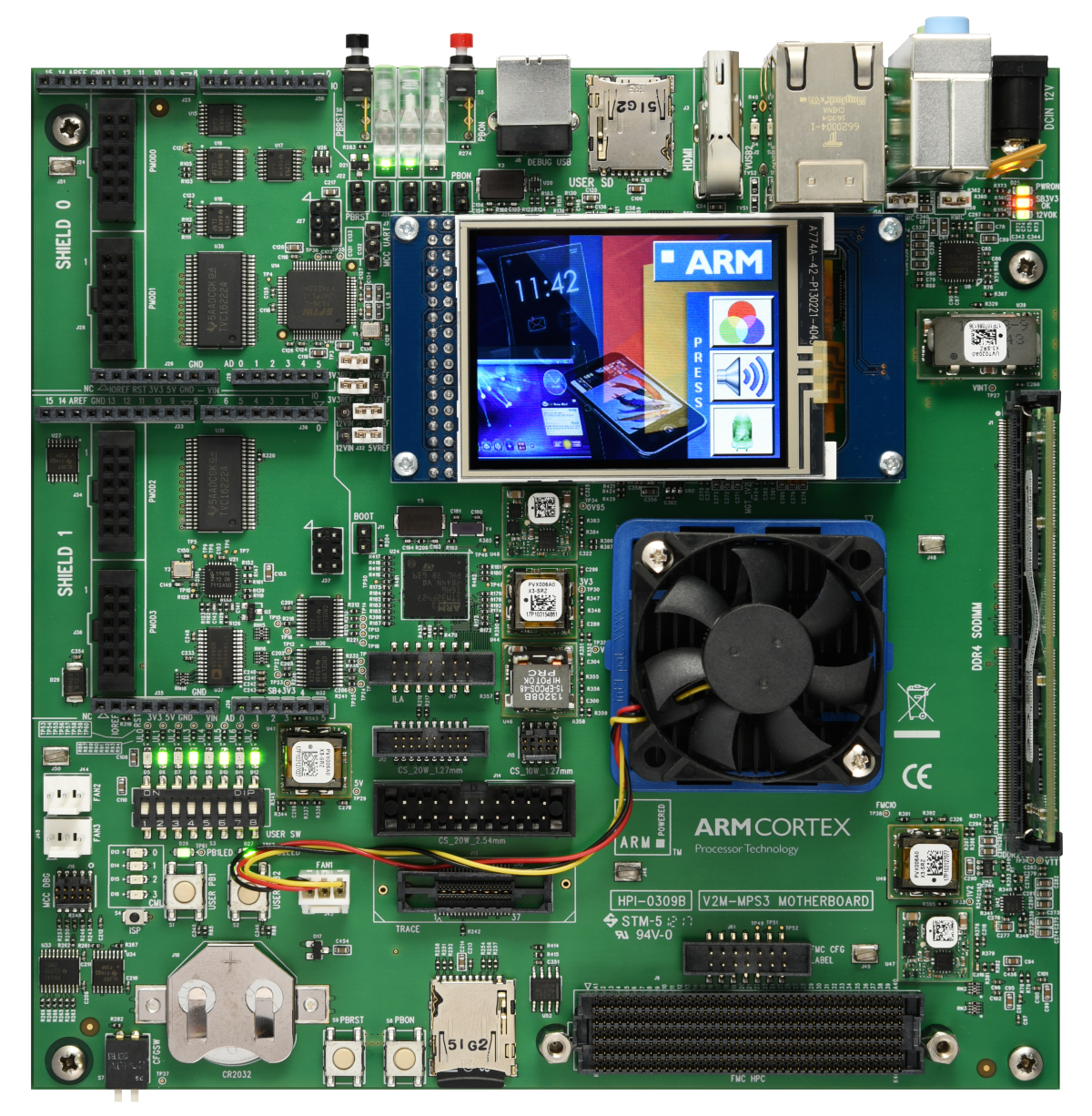lv_port_an547_cm55_sim
 lv_port_an547_cm55_sim copied to clipboard
lv_port_an547_cm55_sim copied to clipboard
A LVGL porting for Cortex-M55 running on an Arm official FPGA prototyping development board called MPS3 (AN547), see Figure 1. It is also possible to run the project template on an emulator called Cor...
lv_port_mps3_an547_cm55
A LVGL porting for Cortex-M55 running on an Arm official FPGA prototyping development board called MPS3 (AN547), see Figure 1. It is also possible to run the project template on an emulator called Corstone-300-FVP, which is free.
Figure 1 Arm MPS3 FPGA prototyping board

Features
-
LVGL 9.0.0-dev (CMSIS-Pack)
-
[New] Arm-2D (Helium) acceleration is added !!!
- see
lv_gpu_arm2d.candlv_gpu_arm2d.h - Attach acceleration in
lv_port_disp_template.c - Arm-2D CMSIS-Pack
- see
-
320 * 240 RGB565 LCD Display connected with an Integrated Color LCD parallel interface.
-
Default System Clock: 32MHz (50MHz Max)
-
CPU: Cortex-M55 with Helium
- DCache
- ICache
- ITCM: 512KB
- DTCM: 512KB
-
NPU: Ethos-U55
-
PRAM (Used for Code and RO-Data): 2MByte
-
SRAM: 4MByte
-
DDR4: 1GByte
-
MDK Project with Arm Compiler 6
Acceleration Using Arm-2D
A benchmark report shows the advantage of using arm-2d to accelerate LVGL when Helium technology is available.
How To Use
How to run the simulation
- Download the Corstone-300-FVP and install it.
- Open the project in MDK
- Select the 'Cortex-M55_FVP' configuration.
- Open the 'Options for Target' window and select the 'Debug' panel
- Press the 'Settings' button on the right corner
- Click the '...' button on the top-right corner, browse to the folder where Corstone-300-FVP is installed and select the executable file, i.e. FVP_Corstone_SSE-300_EThos-U55.exe.
Usually the Corstone-300-FVP is located in the following path:
C:\Program Files\ARM\FVP_Corstone_SSE-300\models\Win64_VC2017\FVP_Corstone_SSE-300_Ethos-U55.exe
- Click the '...' button next to the 'Target' textbox and select the cpu0 in the popup dialog. Click OK to confirm.
- Click the OK button to close the 'Models Armv8-M Target Driver Setup' window.
- Compile and Debug. You should be able to see the LVGL benchmark running on a FVP window as shown below:
NOTE:
-
FVP can ONLY be used to verify the correctness of firmware functionality
-
NO performance data generated from FVP is trustworthy. FVP is simply NOT designed for performance evaluation.
For example, the '-O0' optimization might run as fast as -Ofast, in contrast, the '-Ofast+LTO (Link-Time-Optimization)' runs very slow. In fact, in the real hardware, -Ofast+LTO > -Ofast >> -O0.
How to Run on MPS3
- Open the project in MDK
- Select the 'Cortex-M55_MPS3' configuration
- Compile and Debug
LVGL Porting Exercise
For people who want to learn and practice porting LVGL to a LCD-Ready MDK project using the LVGL cmsis-pack, a dedicated branch called "lvgl_porting_exercise" is introduced, which contains a clean project and provides:
- Low-level LCD APIs
extern int32_t GLCD_Initialize (void);
extern int32_t GLCD_Uninitialize (void);
extern int32_t GLCD_SetForegroundColor (uint32_t color);
extern int32_t GLCD_SetBackgroundColor (uint32_t color);
extern int32_t GLCD_ClearScreen (void);
extern int32_t GLCD_SetFont (GLCD_FONT *font);
extern int32_t GLCD_DrawPixel (uint32_t x, uint32_t y);
extern int32_t GLCD_DrawHLine (uint32_t x, uint32_t y, uint32_t length);
extern int32_t GLCD_DrawVLine (uint32_t x, uint32_t y, uint32_t length);
extern int32_t GLCD_DrawRectangle (uint32_t x, uint32_t y, uint32_t width, uint32_t height);
extern int32_t GLCD_DrawChar (uint32_t x, uint32_t y, int32_t ch);
extern int32_t GLCD_DrawString (uint32_t x, uint32_t y, const char *str);
extern int32_t GLCD_DrawBitmap (uint32_t x, uint32_t y,
uint32_t width, uint32_t height, const uint8_t *bitmap);
-
A simple main() function
-
A simple way to display string on LCD
extern
int32_t GLCD_DrawString(uint32_t x, uint32_t y, const char *str);
#define __LL_LCD_PRINT_BANNER(__STR) \
do { \
GLCD_DrawString( (GLCD_HEIGHT) / 2 - 8, \
(GLCD_WIDTH - sizeof(__STR) * 6) / 2, \
__STR); \
} while(0)
- printf() is retargeted to USART0 (telnet in FVP emulation).
- A function, GLCD_DrawBitmap(), for flushing display buffer to LCD, which supports window-mode (partial flush).
extern
int32_t GLCD_DrawBitmap (uint32_t x, uint32_t y,
uint32_t width, uint32_t height,
const uint8_t *bitmap);
- Ready to Compile and Debug in FVP (Emulation) as shown in Figure 2.
Figure 2 A Clean Project Template for practicing LVGL Porting using LVGL CMSIS-Pack
- A new method, __cycleof__(), for measuring cpu cycles consumed by specified code segment.
__cycleof__("Draw strings on LCD") {
__LL_LCD_PRINT_BANNER("Hello LVGL!!");
}
Figure 3 printf() and __cycleof__

License
- LVGL used in this project is under MIT license.
- This project template is under Apache 2.0 license.
- Arm-2D used in this project is under Apache 2.0 license.






